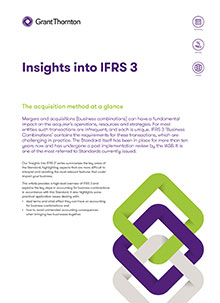-
Un réseau international puissant et intégré
Un réseau international fédéré autour d’une promesse commune Go Beyond – Allons plus loin ensemble.
-
Digital Audit - Audit Data Analytics
A l’instar de nos clients, de toutes tailles et opérant dans toutes les industries, notre activité audit se transforme et innove, en adoptant et en développant des technologies pour une innovation pragmatique et partagée.
-
Doctrine comptable
Le département Doctrine Comptable intervient en soutien des équipes Grant Thornton pour l’accompagnement de leurs clients dans leurs problématiques de reporting comptable et financier, et dans l’appréhension des nouveaux chantiers comptables.
-
L’Audit au cœur des territoires par Grant Thornton
Grâce à une implantation au cœur des territoires (24 bureaux), nos équipes Audit accompagnent les groupes internationaux côtés, les ETI et entreprises familiales, les organisations du secteur public, les associations aux quatre coins de l’Hexagone.
-
Public - Economie sociale - Protection Sociale (PEPS)
Notre offre pour les secteurs Public, Économie sociale et logement social, Protection Sociale couvre l’ensemble de nos métiers et expertises dont l’Audit. Grant Thornton est l’auditeur légal de nombreux hôpitaux, établissements publics, collectivités, OPH, mutuelles…
-
Financial Services
Nos équipes d’audit accompagnent les établissements financiers, les sociétés de gestion d’actifs et les entreprises d’assurance.
-
People & Culture
Chez Grant Thornton, nous vous offrons l’occasion de vivre l’Expérience de la Confiance en révélant le meilleur de vous-même au sein d’équipes conviviales et soudées.

-
Audit contractuel – Diagnostic
Un large spectre d’audits contractuels et de diagnostics couvrant l’ensemble des attentes des acteurs économiques.
-
Audit Durabilité et Audit extra-financier
Notre offre au service d’un développement durable dorénavant au centre de la stratégie des entreprises, source de création de valeur et de sens.
-
Audit des systèmes d’information (SI)
Dans un monde toujours plus digital, les auditeurs spécialistes en systèmes d’information de Grant Thornton accompagnent nos clients dans la gestion des risques liés à leurs SI.
-
Accompagnement à l’application de la directive CSRD
Nous vous proposons de mieux appréhender les nouveautés de la CSRD. Nos Experts vous permettront de préparer la réalisation de ce futur exercice dans les meilleures conditions.
-
Expertise indépendante
Les Associés experts judiciaires de Grant Thornton sont régulièrement désignés par les Cours ou Tribunaux en qualité d’experts, mais également par les Parties comme arbitres, tiers évaluateurs ou experts techniques.
-
Capital Markets
L’équipe Capital Markets de Grant Thornton accompagne les émetteurs dans la maîtrise de la réglementation boursière et de leur communication financière.
-
Certification des comptes de collectivités territoriales
Nos expertises en matière d’Audit et de certification des comptes de collectivités territoriales.
-
Commissariat aux apports et à la fusion
Régulièrement désigné Commissaire aux apports ou à la fusion, Grant Thornton a constitué une équipe dédiée pluridisciplinaire susceptible de répondre à tous les types d’opérations.
-
Digital Audit - Audit Data Analytics
A l’instar de nos clients, de toutes tailles et opérant dans toutes les industries, notre activité audit se transforme et innove, en adoptant et en développant des technologies pour une innovation pragmatique et partagée.
-
Institutions européennes et internationales
Pour répondre aux enjeux des institutions européennes et internationales, Grant Thornton propose des missions d’audit (financiers, des SI, de projets).

-
Transaction Services
Transaction services : un ensemble de compétences et de services au service des transactions réalisées par les acteurs du capital-investissement, les investisseurs et les entreprises
-
Restructuring Services
Nos services de prévention et restructuration appelés Restructuring Services, mieux anticiper pour favoriser le traitement des difficultés des entreprises
-
Valuation Services
Nos Experts accompagnent les acteurs du capital-investissement, les entreprises acquisitives et les investisseurs en matière d’évaluation d’entreprise
-
Operational Deal Services
Des services adressant les enjeux opérationnels au cœur des deals
-
Finance
Notre activité en Conseil Finance rassemble des experts spécialisés dans la transformation de la fonction Finance. Nous accompagnons les Directions financières des entreprises de toute taille dans leur transformation globale.
-
Achats
Notre activité en Conseil Achats et Supply Chain rassemble des experts en achats spécialisés sur toutes les catégories et en conseil pour l’optimisation et la structuration de la fonction Achats / Approvisionnements.
-
RH - Talents et Organisation
Notre activité en Conseil RH, Talents & Organisation, rassemble des experts spécialisés en matière d’organisation, de processus et de solutions digitales, pour accompagner la transformation des entreprises sur l’ensemble des thématiques liées aux Ressources Humaines.
-
DSI
Notre activité en Conseil IT, rassemble des experts spécialisés en matière d’organisation, de processus et de solutions technologiques pour accompagner les DSI dans la définition et la mise en œuvre de la transformation digitale de l’entreprise.
-
Risk Management
La gestion des risques au service de la performance.
-
Compliance and Forensic
Compliance and Forensic
-
Cybersécurité
Définition de votre stratégie de sécurisation et mise en place de solutions techniques, dans une optique de rationalisation des investissements.
-
Data & Automation – La technologie au service de la performance
Chez Grant Thornton, nous accompagnons les Directions Métiers et des Systèmes d’Information sur l’ensemble des problématiques liées à la Data et l’hyper-automation.

-
Automated Reporting and Data Analytics
Optimiser le pilotage financier et opérationnel de votre activité en automatisant la génération de rapports grâce à des outils de reporting dynamiques et des fonctionnalités avancées d’analyse de données et de data visualization comme Power BI.
-
Expertise Comptable
Sécuriser vos obligations réglementaires…et bien. Dans un environnement réglementaire complexe et changeant, nos experts vous accompagnent pour sécuriser vos opérations.
-
Contrôle de gestion
Piloter sa stratégie de développement grâce au contrôle de gestion.
-
Paie, Conseil social & RH
Paie, Conseil social & Ressources Humaines
-
Le Diag Transmission
Le Diag Transmission
-
Assistance opérationnelle aux directions financières
Assistance opérationnelle aux directions financières
-
Accompagnement des acteurs du Capital Investissement
Accompagnement des acteurs Capital Investissement
-
Accompagner les entreprises innovantes
Accompagner le développement des start-up
-
BFR & Cash Management
BFR & Cash Management
-
Le Diagnostic Expert 360°™
Le Diagnostic Expert 360°™ : un nouvel outil de création de valeur pour les dirigeants, à chaque étape de la vie de l’entreprise.

-
Stratégie RSE et Accompagnement CSRD
Définir la stratégie RSE / de transformation durable d’une organisation avec Grant Thornton et accompagner les entreprises dans l’application de la CSRD.
-
Accompagnement opérationnel RSE
Offres d’accompagnement opérationnel en transformation durable aidant les organisations à agir pour un développement durable efficace, pérenne et concret.
-
Conseil en transaction
Services de Conseil en transaction de Grant Thornton : due diligences ESG et environnementale, accompagnement des entreprises du portefeuille au respect des critères extra-financiers.
-
Audit Durabilité et Audit extra-financier
Notre offre au service d’un développement durable dorénavant au centre de la stratégie des entreprises, source de création de valeur et de sens.
-
Finance durable
Services de Conseil en transaction de Grant Thornton : due diligences ESG et environnementales, accompagnement des entreprises du portefeuille au respect des critères extra-financiers
-
Formation et sensibilisation
Services de formation et sensibilisation aux bonnes pratiques du développement durable, de la santé environnementale et de la sécurité sanitaire.

-
Assistance and Advisory
Assistance and Advisory
-
Accountancy and Administration
Accountancy and Administration
-
Compliance
Compliance
-
Payroll Services
Payroll Services
-
Global Compliance and Reporting Solutions
Global Compliance and Reporting Solutions
-
Japan Desk
Le Japan Desk accompagne des entreprises japonaises s’implantant en France et, propose des services aux entreprises françaises ciblant le marché japonais.
-
ジャパン デスク
ジャパン デスク - Japan Desk
-
Country Desks
Country Desks, International Desks
-
An introduction to our other services
An introduction to our other services

-
 Newsletter Quarterly Deals n°35Dans cette édition de la newsletter du métier Conseil Financier de Grant Thornton, retrouvez une rétrospective du premier semestre 2024, ainsi que nos dernières opérations.
Newsletter Quarterly Deals n°35Dans cette édition de la newsletter du métier Conseil Financier de Grant Thornton, retrouvez une rétrospective du premier semestre 2024, ainsi que nos dernières opérations. -
 La lettre des décideurs N°32 Economie de guerre et financement de la BITD ?Découvrez l’article de Nicolas Tixier dans La Lettre Des Décideurs numéro 32
La lettre des décideurs N°32 Economie de guerre et financement de la BITD ?Découvrez l’article de Nicolas Tixier dans La Lettre Des Décideurs numéro 32 -
 Article Et si la défense nous sauvait des dangers de la désindustrialisation ?Pour refondre la politique de Défense, la France a besoin d’un outil industriel à réadapter, à relocaliser.
Article Et si la défense nous sauvait des dangers de la désindustrialisation ?Pour refondre la politique de Défense, la France a besoin d’un outil industriel à réadapter, à relocaliser. -
 Article Application du devoir de vigilance aux entreprises de l’armementDécouvrez l’article de Nicolas Guillaume sur l’application du devoir de vigilance aux entreprises de l’armement pour l’utilisation des matériels de guerre exportés
Article Application du devoir de vigilance aux entreprises de l’armementDécouvrez l’article de Nicolas Guillaume sur l’application du devoir de vigilance aux entreprises de l’armement pour l’utilisation des matériels de guerre exportés
-
Assurance
La plateforme Grant Thornton dédiée à l’assurance et aux mutuelles.
-
Banque et Asset Management
Accompagner les institutions bancaires pour construire les fondamentaux de leurs nouveaux business models.

-
Secteur public
Grant Thornton, partenaire des acteurs publics
-
Economie sociale
Nos offres de services Grant Thornton dédiées aux secteurs médico-social et de l’habitat social.
-
Protection Sociale
Nos offres de services Grant Thornton dédiées aux mutuelles, institutions de prévoyance, organismes de sécurité sociale et de retraite complémentaire.

Grant Thornton International vient de publier le premier article d’une série consacrée aux opérations de « regroupements d’entreprises » et à la norme IFRS 3 : Insights into IFRS 3 - The acquisition method at a glance.
Ce premier ‘ Insights into IFRS 3’ propose un résumé des points clés de la norme en soulignant les domaines pour lesquels il peut y avoir des difficultés d’interprétation ou qui sont de nature à affecter le plus sensiblement les activités de l’acquéreur.
Il donne un aperçu général de la norme IFRS 3 en expliquant les étapes essentielles et incontournables dans la comptabilisation des regroupements. Il vise aussi à attirer l’attention sur les problématiques d’application pratiques qui sont souvent liées à la structuration des accords et la façon dont ils peuvent affecter la comptabilisation des regroupements ou encore aux effets ou répercussions inattendus et souvent indésirables qu’il convient d’appréhender lors du regroupement de 2 activités.
Découvrez ci-dessous la présentation de ce document en anglais.
Mergers and acquisitions (business combinations) can have a fundamental impact on the acquirer’s operations, resources, and strategies. IFRS 3 ‘Business Combinations’ is one of the most referred to Standards currently issued and contains the requirements for these transactions, which are challenging in practice.
This article provides a high-level overview of IFRS 3 and explains the key steps in accounting for business combinations in accordance with this Standard. It also highlights some practical application issues dealing with:
- deal terms and what effect they can have on accounting for business combinations
- how to avoid unintended accounting consequences when bringing two businesses together.
The acquisition method
IFRS 3 establishes the accounting and reporting requirements (known as ‘the acquisition method’) for the acquirer in a business combination. The key steps in applying the acquisition method are summarised below:
Effect of deal terms on the accounting for business combinations
The terms and structures of sales and purchase agreements vary extensively, and they will determine how a business combination should be accounted for. It is important that management is aware of the financial reporting consequences of putting in place certain terms and conditions into sale and purchase agreements. The following summarises some common deal terms and their related effects on the financial reporting for business combinations.
Reporting business combinations and avoiding surprises
Reporting a business combination is a significant exercise. A considerable amount of time and effort usually needs to be put into gathering, assembling and evaluating all the information required to be reported in the financial statements under IFRS 3. Presented below are some planning considerations and suggestions on how they can be implemented.
We hope you find the information in this article helpful in giving you some insight into IFRS 3.




















